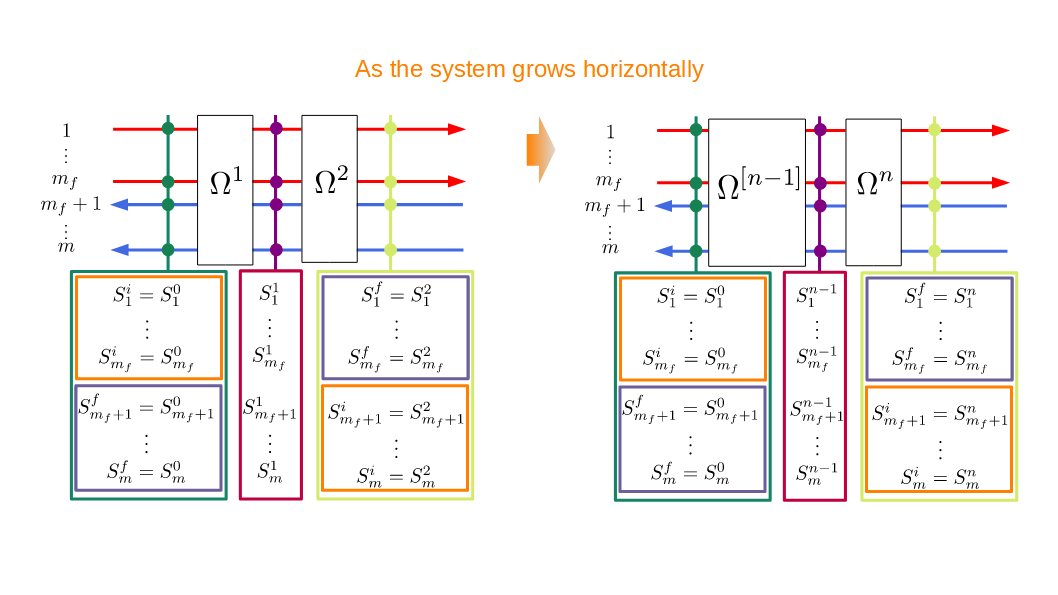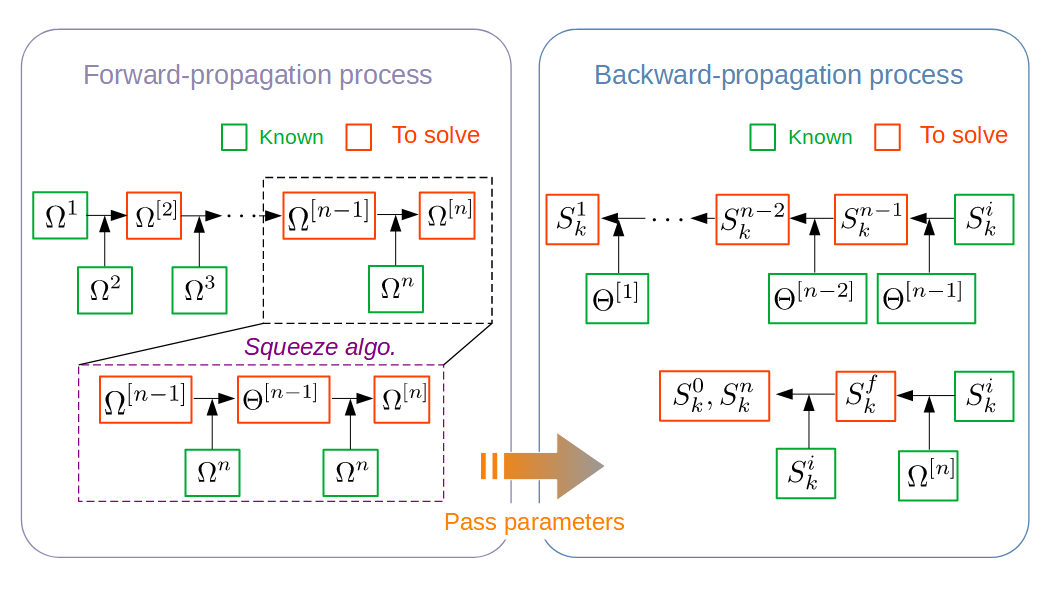Interacting Counter-propagating Flows
algorithms aiming at solving all interactions
You may find a blog titled “A Duo Traveling Reversely” describing more details alongside this exploration.
We describe a methodology that addresses the consequence of sequential interactions between counter-propagating flows. Though being sparsely discussed, the nature of interaction between counter-propagating flows is fundamentally distinct from that between co-propagating flows, featured by bidirectional, convoluted information flow. To the best of our knowledge, a complete picture of sequential interactions between counter-propagating flows is still lacking.
We develop a set of algorithms that are responsible for breaking this convoluted interaction process down into solvable sub-problems. The ultimate goal is to achieve the transition matrix connecting initial and final states of counter-propagating flows, and also intermediate states in between interactions, in turn visualizing the evolution of flows via interactions.
In particular, a low-level algorithm, referred to as “squeeze”, is to calculate the transition matrix connecting initial states and final states for a minimum sequence containing two interactions. To calculate a longer sequence, this squeeze algorithm would be invoked repeatedly to take new interactions into account as moving forwardly in a sequence, referred to as forward-propagation algorithm. Lastly, another (backward-propagation) algorithm acts backwardly to calculate intermediate states. In condensed matter physics, this methodology extends the application of Landauer-Büttiker formalism into the domain of highly-correlated edge transport.
Algorithm Design
Here all three algorithms will be introduced individually, which collectively find out the matrix representation of combined effect of sequential interactions and all intermediate states.
Squeeze Algorithm
This algorithm is named for the fact the calculation is carried out simultaneously from both ends towards the middle of the sequence of interactions, resembling the action of squeezing. In short, this algorithm comprises three major steps: a. Connect initial states with the intermediate states; b. Connect intermediate states with the final states; c. Connect initial states and the final states via the connections established in steps a) and b). This algorithm acts as a low-level agent and will be invoked repeatedly.

Forward-propagation Algorithm
This algorithm starts with the head of the sequence, and then keeps adding following interactions into the calculation process, pushing the calculation forwardly till reaching the last interaction at the end of the sequence. In each iteration, this high-level algorithm will invoke aforementioned “squeeze method” for adding a subsequent interaction. Ultimately, this algorithm would yield the matrix representation of sub-sequences (from the first to the interaction in process) and a series of hidden parameters necessary for calculating intermediate states later.
Backward-propagation Algorithm
This algorithm is aimed to derive all intermediate states between interactions backwardly. Employing this algorithm requires matrix representations and hidden parameters passed by the forward-propagation process.

Making Use of Algorithms in Condensed Matter Physics
Quantum Hall Effect and Edge-state Picture
When a two-dimensional (extremely thin film), highly-conducting (high crystalline quality) semiconductor-like material ( e.g., GaAs heterostructure) is subject to a vertically aligned magnetic field (approx. 6 orders of magnitude stronger than Earth’s magnetic field), a profound and intriguing phenomenon, referred to as quantum Hall effect., appears and has been extensively studied since its birth in 1980. In history, several Noble Prizes have been awarded to related discoveries in 1985 , 1998 , 2016. Aside from its deeper physical implication like topology in physics , a well-celebrated, trustful “edge-state” physical picture for this phenomenon is that, electrons are forced to move alongside the thin film edges in one direction, forming dissipationless “edge states” (electron flows). Without delving into deeper theory, a “magic” force seems to guide the motion of electrons. Nevertheless, this simple picture is accurate enough to be applicable in academic discussions and exciting enough to spur expectations of revolution in the field of electric power transmission if no magnetic field is needed (See quantum spin Hall effect).
Landauer-Büttiker Formalism and Interaction between Edge States
Back to “edge states”, this unique “bullet-like” (ballistic) motion of electrons can be most suitably described by a model developed by Markus Büttiker in early 80s based on Rolf Landauer’s earlier work, later referred to as Landauer-Büttiker formalism . Often we do not assume these edge states interact with each other or exchange electrons. In a typical device with terminals (electron reservoirs), interactions between edge states are in principle not discernible if all edge states move in the same direction (a co-propagating mode). This is because that co-propagating edge states themselves are identical in terms of physical properties like electrochemical potential and any exchange between them would not lead to any observable consequence. In order to detect this type of interaction, dedicated device design is needed to divert co-propagating edge states into different paths. For counter-propagating edge states, this interaction is directly measurable even in a standard device (uniform path).
Realize Individual Paths of Edge States
I would like to highlight the implementation of dynamic programming, which allows for diverting edge states into different paths.
In a standard Landauer-Büttiker system, all edge states enter each terminal without exception. The electronic measurement is only performed via terminals which measure all edge states at once. Consequently, this measurement result is an average of all edge states in terms of electro-chemical potential.
To extract additional information of edge states, it is advisable to block some of them from particular terminals, leading to different paths. In other words, this additional controls imposed on edge states may reveal hidden information, not detectable in conventional configuration (standard Landauer-Büttiker system). However, a complex blockage pattern may also cause difficulty in defining the blocked edge state, because that the information carried by these edge states, not detectable by terminals, spread into other edge states via interactions directly or indirectly. An algorithm is developed to resolve this complexity recursively.
Code implementation
The source code of this open-source project is hosted in Github.
The design principle for usage is to facilitate the bottom-up construction of a system from the building block - interaction. Here is a snapshot to illustrate how easy it is to build a system and visualize the relevant results.
